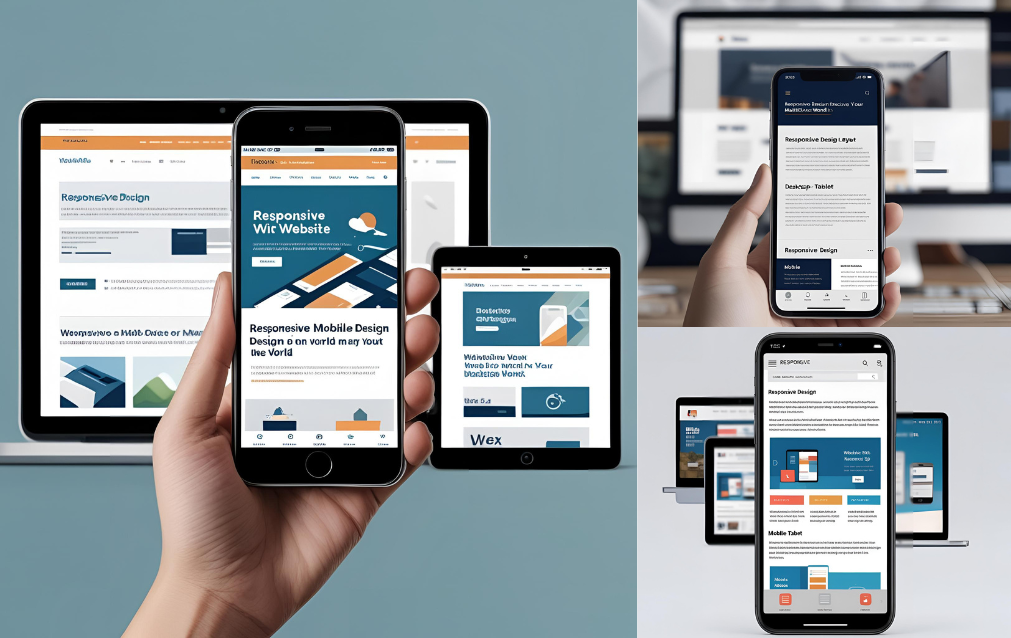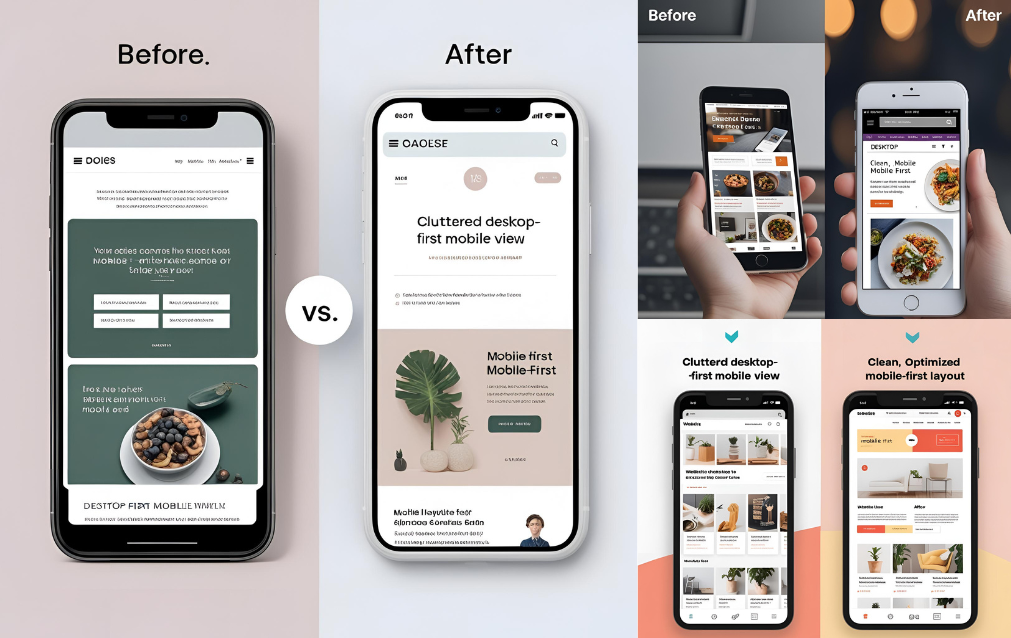Mobile-First Web Design Introduction:
In 2025, your website isn’t just a digital business card it’s the front door to your brand, and most visitors are knocking from their smartphones. Gone are the days when desktop ruled the web; today, mobile devices account for nearly 60% of global website traffic.
If your site isn’t optimized for mobile-first, you’re not just missing out you’re actively turning away clients, tanking your SEO, and leaving money on the table. Mobile-first design, which prioritizes mobile experiences before scaling up to larger screens, has evolved from a “nice-to-have” to an absolute must.
In this article, we’ll explore why it’s no longer optional, the hidden costs of ignoring it, how to implement it effectively, emerging trends shaping the future, and tips to future-proof your site. Buckle up your website’s survival depends on it.
The Mobile Domination: Stats That Can’t Be Ignored
Let’s start with the cold, hard facts. As of April 2025, mobile devices drive about 59.7% of global website traffic, up from previous years as more people rely on smartphones for everything from shopping to research. This shift isn’t slowing down; projections show mobile traffic could hit 80% by the end of the decade. But traffic is just the tip of the iceberg. Google’s mobile-first indexing, in place since 2019, now fully prioritizes the mobile version of your site for ranking. If your mobile site is subpar, your entire SEO suffers desktop included.
User behavior amplifies the urgency. A staggering 53% of mobile users abandon sites that take longer than three seconds to load. That’s not just a bounce; it’s lost revenue. Mobile users engage 15% more with responsive platforms, leading to increased clicks and longer sessions that boost search rankings. For e-commerce, the stakes are even higher: poor mobile UX contributes to 70% cart abandonment rates, costing businesses billions annually. In a world where consumers expect seamless experiences, a non-mobile-first site screams “outdated” and sends them straight to competitors.
Beyond stats, consider the demographic shift. Gen Z and Millennials, who make up over 50% of the workforce and consumer base in 2025, are mobile natives. They shop, bank, and connect on the go, and they’re quick to judge. A clunky mobile site erodes trust faster than a bad review. Businesses ignoring this trend risk not just lower conversions but irrelevance in a mobile-centric economy.

The Business Case: Benefits of Going Mobile-First
Adopting mobile-first isn’t about following trends it’s about smart business. First, it supercharges conversions. Sites designed mobile-first see up to 20% higher conversion rates, as streamlined navigation and touch-friendly elements make purchasing effortless. Think simplified menus, large buttons, and fast-loading images that cater to thumb-scrolling users.
SEO benefits are massive. Google’s algorithms favor mobile-optimized sites, rewarding them with higher rankings and more organic traffic. In 2025, with voice search and AI assistants like Siri and Google Assistant dominating mobile queries, sites without mobile-first design get buried. Plus, responsive design reduces duplicate content issues, streamlining your SEO efforts.
Cost-wise, mobile-first saves money long-term. Building from mobile up ensures scalability adding desktop features is easier than retrofitting a desktop site for mobile. This approach cuts development time by 30-40% and minimizes future redesigns. For small businesses, it’s a game-changer: tools like Bootstrap or Tailwind CSS make implementation affordable without sacrificing quality.
User satisfaction skyrockets too. Mobile-first sites load faster, use less data, and feel intuitive, leading to longer dwell times and repeat visits. In an era where 60% of users prefer simple websites over complex ones, minimalistic mobile designs win hearts and wallets. Brands like Amazon and Starbucks exemplify this, with mobile apps and sites driving 70% of their traffic and sales.
Common Pitfalls: Why Some Sites Still Fail Mobile
Despite the evidence, many sites lag behind. One big mistake: treating mobile as an afterthought. Desktop-first designs often result in cramped mobile views with tiny text and unclickable links, frustrating users. Another issue: ignoring performance. Heavy images or unoptimized code can make sites sluggish on mobile networks, where speeds vary.
Accessibility is overlooked too. In 2025, with regulations like the ADA pushing for inclusive design, non-mobile-first sites risk lawsuits if they don’t support screen readers or voice navigation on mobile. Finally, failing to test on real devices leads to surprises emulators don’t catch everything, like battery drain from inefficient code or touch gesture issues.
How to Implement Mobile-First Design Effectively
Ready to make the switch? Start with mindset: design for the smallest screen first. Use media queries in CSS to progressively enhance for larger devices. Frameworks like Bootstrap 5 or Materialize provide mobile-first grids out of the box.
Prioritize speed: Compress images with tools like TinyPNG, lazy-load non-essential elements, and minify code. Aim for under two-second load times AMP (Accelerated Mobile Pages) can help for content sites. Navigation should be thumb-friendly: hamburger menus, large tap targets (at least 48×48 pixels), and swipe gestures.
Test rigorously. Use Google’s Mobile-Friendly Test and Lighthouse for audits. Real-user testing via platforms like UserTesting reveals pain points. Integrate analytics to track mobile bounce rates and conversions, tweaking as needed.
For e-commerce, focus on seamless checkout: one-tap payments, auto-fill forms, and progress indicators. Tools like Shopify or WooCommerce offer mobile-first themes to get started quickly.
If you’re redesigning an existing site, audit first: Identify mobile bottlenecks with Hotjar heatmaps. Budget for a professional if needed freelancers on Upwork can deliver mobile-first revamps for $2,000–$5,000, a worthwhile investment.

Emerging Trends in Mobile-First Design for 2025
2025 brings exciting evolutions. AI-powered personalization is huge: 79% of mobile engineers believe AI will transform app development, enabling dynamic content that adapts to user behavior in real-time. Think personalized product recommendations or layouts based on past interactions. Progressive Web Apps (PWAs) are mainstream, blending app-like experiences with web accessibility. They load offline, send push notifications, and install on home screens, boosting engagement by 137% for some brands. Sustainable design gains traction: Eco-friendly sites use less data and energy, appealing to environmentally conscious users.
Simplified journeys, interactive elements like AR previews, and bold, block-based layouts with vibrant contrasts define aesthetics. Voice search optimization is key, with natural language queries rising 20% yearly. Immersive experiences via WebXR bring VR/AR to mobile browsers, perfect for retail or education. And with 5G widespread, expect richer media without performance hits.
Challenges and How to Overcome Them
Mobile-first isn’t without hurdles. Designing for diverse devices foldables, wearables requires extra effort. Solution: Use flexible grids and test on emulators like BrowserStack.
Content prioritization can be tricky: What fits on mobile? Focus on core value cut fluff, use accordions for details. Team buy-in is another issue; educate stakeholders on ROI with case studies.
Budget constraints? Start small: Optimize existing sites with responsive updates before a full redesign. Free tools like Google’s PageSpeed Insights guide improvements.
Getting Started: Your Mobile-First Action Plan
Audit your current site: Run Google’s tools and note issues. Set goals e.g., reduce load time by 50%. Choose tools: CSS frameworks for devs, builders like Elementor for non-coders.
Build a prototype: Sketch mobile wireframes in Figma. Develop, test, launch. Monitor with analytics and iterate. Join communities on X (#MobileFirst or #WebDesign) for tips.
For businesses, partner with agencies specializing in mobile-first they’ll ensure compliance and performance.

Wrapping Up
In 2025, mobile-first web design is non-negotiable. With mobile dominating traffic, influencing SEO, and driving conversions, ignoring it costs you clients, rankings, and growth. On the other hand the benefits include higher engagement, cost savings, future-proofing far outweigh the effort. By embracing trends like AI personalization, PWAs, and sustainable practices, you’ll not only survive but thrive in a mobile world. Don’t wait for competitors to lap you; audit your site today, implement mobile-first principles, and watch your digital presence soar. Is your website ready for 2025? Make it mobile-first, and the answer will be a resounding yes.
Note: Most of our articles are generated with Artificial Intelligence including this and are reviewed by researchers before publishing. For consulting visit: HERE
